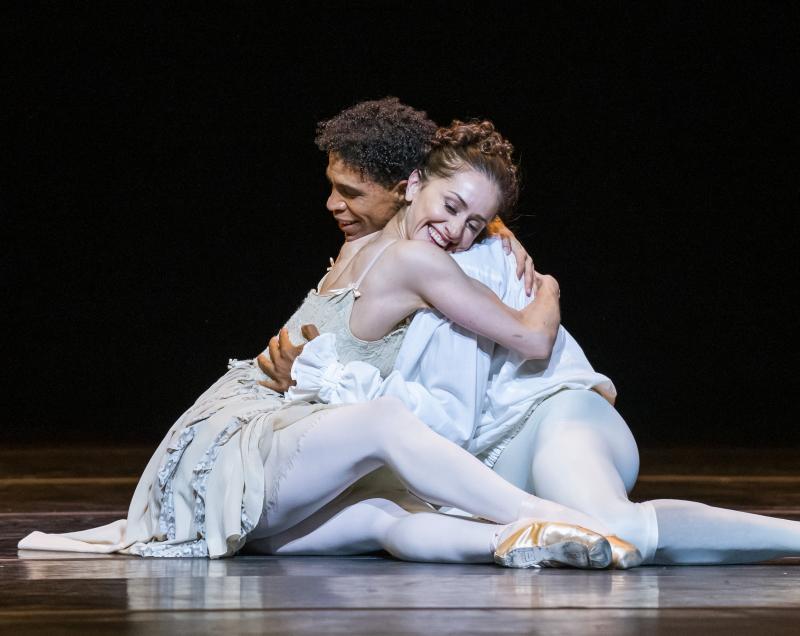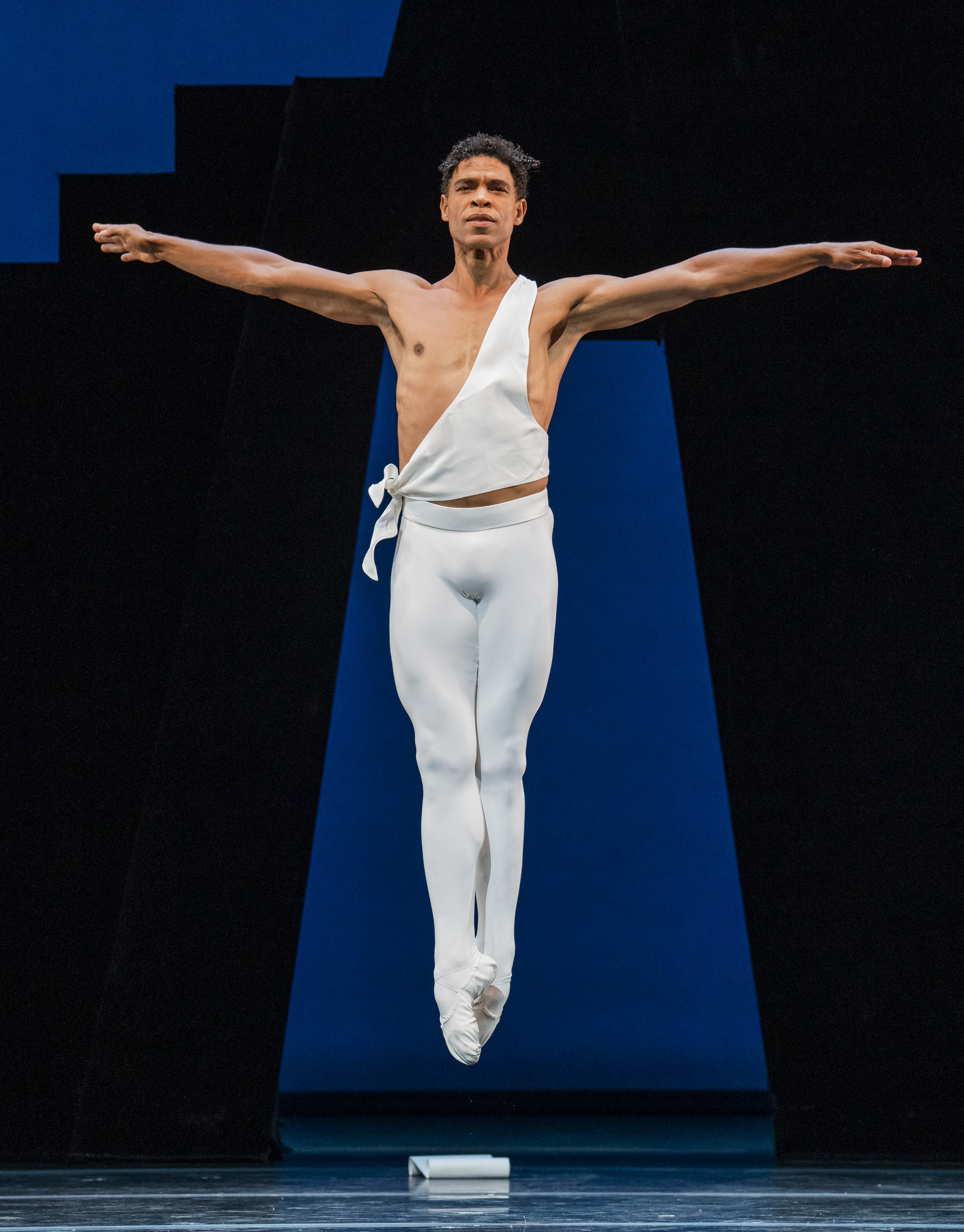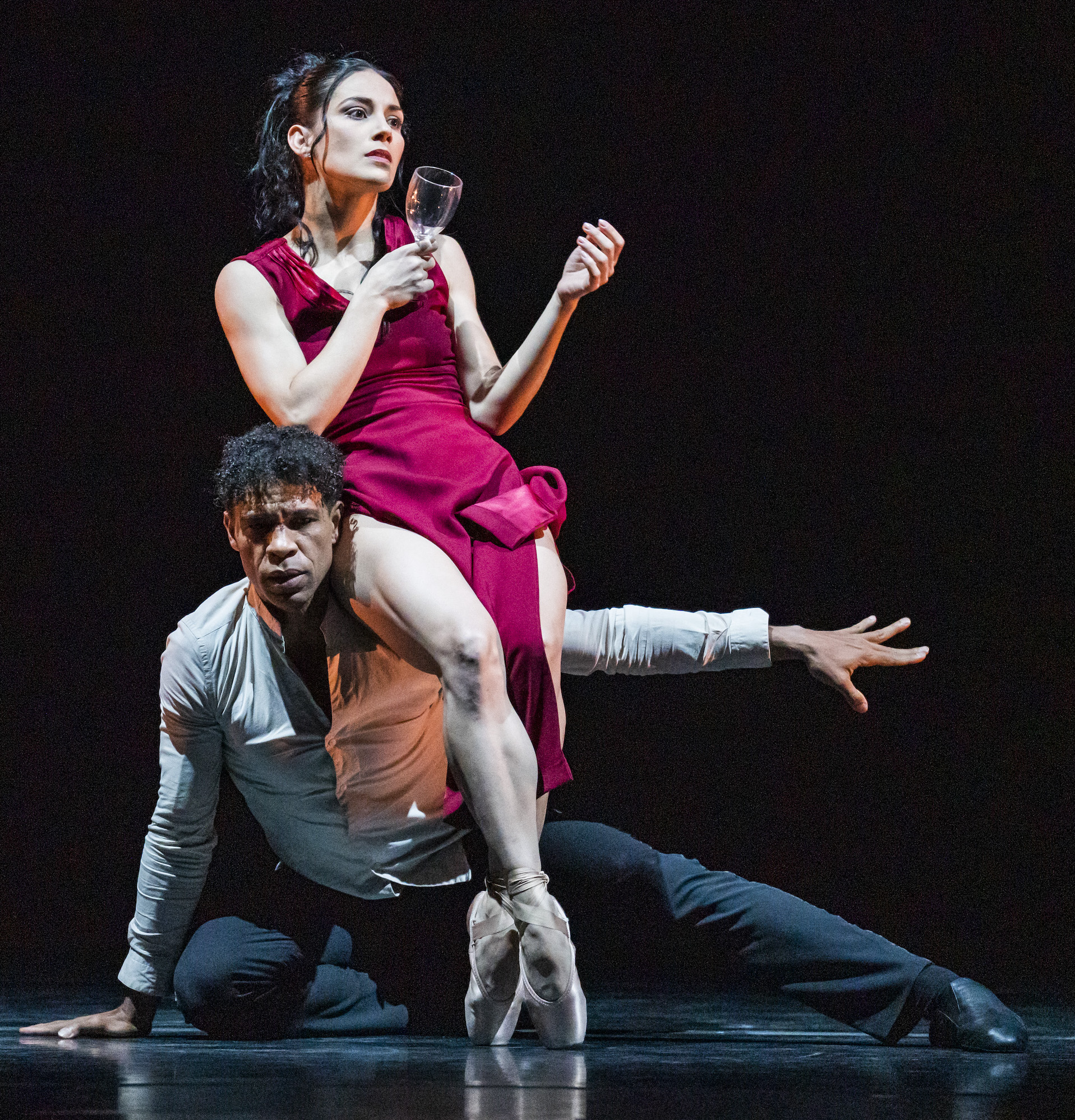Carlos at 50, Royal Opera House review - lovingly designed gala from a still impressive star | reviews, news & interviews
Carlos at 50, Royal Opera House review - lovingly designed gala from a still impressive star
Carlos at 50, Royal Opera House review - lovingly designed gala from a still impressive star
The Cuban dancer is a living tribute to the power of the arts

On the day Mick Jagger turned 80, that spring chicken Carlos Acosta, 50 this year, returned to the stage of the Royal Opera House, which he had left in 2015 after 17 years. Carlos at 50 was a wonderfully sunny, warm embrace of a return: the audience greeted his first appearance ecstatically, and his wide grin reflected how happy he was to be there too.
In an unusual and clever move, Acosta chose to open the three-hour evening with Apollo (pictured below), the Balanchine piece to Stravinsky that was one of his favourites. It calls on the more delicate stage skills he has developed, beyond the big leaps that earned him the honour of dancing Spartacus at the Bolshoi. He showed he still has a spring in his step and elegance in his lines, if not the elevation off the ground of old.
It was also a cheeky way of underlining his current role as a figurehead of the arts, with Terpsichore (danced by the Royal Ballet’s Marianela Nuñez) as his main muse. Alongside her were two excellent dancers from Acosta’s Birmingham Royal Ballet, Lucy Waine and Céline Gittens. To come in the next nine items were more of his BRB dancers and a squad from his Cuban company, Acosta Danza.
If there was ever a living rebuke to the current government's myopic thinking about the importance of the arts, surely Acosta is it. HIs ascendancy from wayward football-mad teenager in Havana to internationally revered star performer and ballet director is still a marvel. Now he Is adding to it: the first of his five shows came on the day it was announced he was creating a London dance hub at Woolwich Works, already the base for his foundation, which will hold classes, stage performances and award choreography scholarships. Apollo indeed.
 The evening moved on to Acosta’s choreography for Carmen, where a classical duet for Carmen (Laura Rodriguez) and Don Jose (BRB’s Javier Rojas) bumped up against flamenco and paso doble moves for a sultry ensemble; then on to Acosta in duets from two more Royal Ballet roles, Siegfried in Swan Lake and Des Grieux in Manon. In both, Nuñez demonstrated why she is the Royal’s leading lady: refined and rock-steady in technique, but with a glimmer of passion waiting to erupt. And here we had Acosta the ideal attentive partner and subtle actor — a delicate Siegfried, touching his beloved Odette for the first time, and, as Des Grieux, a giddy young man once again, sexy and adoring of his fatal new love.
The evening moved on to Acosta’s choreography for Carmen, where a classical duet for Carmen (Laura Rodriguez) and Don Jose (BRB’s Javier Rojas) bumped up against flamenco and paso doble moves for a sultry ensemble; then on to Acosta in duets from two more Royal Ballet roles, Siegfried in Swan Lake and Des Grieux in Manon. In both, Nuñez demonstrated why she is the Royal’s leading lady: refined and rock-steady in technique, but with a glimmer of passion waiting to erupt. And here we had Acosta the ideal attentive partner and subtle actor — a delicate Siegfried, touching his beloved Odette for the first time, and, as Des Grieux, a giddy young man once again, sexy and adoring of his fatal new love.
In between, Acosta programmed roles he doesn’t attempt now — such as the duet from Le Corsaire, full of scissor kicks and travelling fouettés, that has become a showcase for all rising stars. Here it was ably danced by Yonah Acosta, Carlos’s nephew, and Yonah’s wife Laurretta Summerscales, both formerly of ENB, now at the Bavarian State Ballet.
In a run of pieces in the second section, the mood darkened. Acosta paid tribute to the Englishman he is indebted to, Ben Stevenson, who, as a non-American, was able to extricate him from Cuba and take him to Houston Ballet. Stevenson’s End of Time Pas de Deux, silkily danced by Enrique Corrales and Yaoquian Shang to the mournful sounds of a Rachmaninov cello sonata, struck a rare note of apocalyptic doom.
It was followed by a predictably astonishing solo from Brandon Lawrence, Valery Panov’s Liebestod, to the finale of Wagner’s Tristan and Isolde. Lawrence has been a BRB highlight, now departing for Ballett Zürich. Almost naked and curled up with his back to the audience, foetal style, he slowly awoke and explored his own physicality, bit by bit, then bloomed into arabesques and jetés, revelling in his own flesh, before subsiding and returning to his foetal shape. A showstopper.
For the final section, Acosta staged two curios, the first his double-take on the Fokine standard The Dying Swan. Here we had The Dying Swans, in which some of the usual choreography for a dignified female dancer — here, the striking Zeleidy Crespo — is joined by a second set created by Acosta for a male dancer (Mario Sergio Elias) that’s all jagged shapes and bent legs, suggestive of a painful, inelegant death. His “music”, all electronic static and bleeps, almost drowns out the Saint-Saens cello ethereally playing in the background, which comes to the fore for the final moments, as both swans expire in their different ways.
 More interesting still was Mermaid, a piece created on Acosta by Sidi Larbi Cherkaoui in 2017, which he still performs impressively. In a darkened space full of dripping sounds, a woman in a long red evening dress (Laura Rodriguez, pictured right) is drunkenly teetering and collapsing. A man solicitously tries to help her stand, but she keeps slithering away, until finally he stands her under a long fall of water and they part. Each gets a solo, Acosta’s more demanding than you would imagine a 50-year-old could ever manage, exec uted perfectly, while Rodriguez performs with a slinkyelasticity that’s wonderful to watch: look out for her when Acosta Danza next tour here.
More interesting still was Mermaid, a piece created on Acosta by Sidi Larbi Cherkaoui in 2017, which he still performs impressively. In a darkened space full of dripping sounds, a woman in a long red evening dress (Laura Rodriguez, pictured right) is drunkenly teetering and collapsing. A man solicitously tries to help her stand, but she keeps slithering away, until finally he stands her under a long fall of water and they part. Each gets a solo, Acosta’s more demanding than you would imagine a 50-year-old could ever manage, exec uted perfectly, while Rodriguez performs with a slinkyelasticity that’s wonderful to watch: look out for her when Acosta Danza next tour here.
She and Acosta then melt into the final scene, set in Cuba, where a band is whipping along the Acosta Danza performers into predictably fluid and exhilarating salsa moves. And Carlos Acosta body-pops. It was a perfect finale to a thoughtfully and lovingly designed programme, topped only by him bringing his three daughters onstage for the curtain call. One of his six-year-old twins seemed even more excited to be there than he was. A memorable showcase for a treasurable man.
- Carlos at 50 at the Royal Opera House until July 30
- More dance reviews on theartsdesk
rating
Explore topics
Share this article
The future of Arts Journalism
You can stop theartsdesk.com closing!
We urgently need financing to survive. Our fundraising drive has thus far raised £49,000 but we need to reach £100,000 or we will be forced to close. Please contribute here: https://gofund.me/c3f6033d
And if you can forward this information to anyone who might assist, we’d be grateful.

Subscribe to theartsdesk.com
Thank you for continuing to read our work on theartsdesk.com. For unlimited access to every article in its entirety, including our archive of more than 15,000 pieces, we're asking for £5 per month or £40 per year. We feel it's a very good deal, and hope you do too.
To take a subscription now simply click here.
And if you're looking for that extra gift for a friend or family member, why not treat them to a theartsdesk.com gift subscription?
more Dance
 'We are bowled over!' Thank you for your messages of love and support
Much-appreciated words of commendation from readers and the cultural community
'We are bowled over!' Thank you for your messages of love and support
Much-appreciated words of commendation from readers and the cultural community
 R:Evolution, English National Ballet, Sadler's Wells review - a vibrant survey of ballet in four acts
ENB set the bar high with this mixed bill, but they meet its challenges thrillingly
R:Evolution, English National Ballet, Sadler's Wells review - a vibrant survey of ballet in four acts
ENB set the bar high with this mixed bill, but they meet its challenges thrillingly
 Like Water for Chocolate, Royal Ballet review - splendid dancing and sets, but there's too much plot
Christopher Wheeldon's version looks great but is too muddling to connect with fully
Like Water for Chocolate, Royal Ballet review - splendid dancing and sets, but there's too much plot
Christopher Wheeldon's version looks great but is too muddling to connect with fully
 iD-Reloaded, Cirque Éloize, Marlowe Theatre, Canterbury review - attitude, energy and invention
A riotous blend of urban dance music, hip hop and contemporary circus
iD-Reloaded, Cirque Éloize, Marlowe Theatre, Canterbury review - attitude, energy and invention
A riotous blend of urban dance music, hip hop and contemporary circus
 How to be a Dancer in 72,000 Easy Lessons, Teaċ Daṁsa review - a riveting account of a life in dance
Michael Keegan-Dolan's unique hybrid of physical theatre and comic monologue
How to be a Dancer in 72,000 Easy Lessons, Teaċ Daṁsa review - a riveting account of a life in dance
Michael Keegan-Dolan's unique hybrid of physical theatre and comic monologue
 A Single Man, Linbury Theatre review - an anatomy of melancholy, with breaks in the clouds
Ed Watson and Jonathan Goddard are extraordinary in Jonathan Watkins' dance theatre adaptation of Isherwood's novel
A Single Man, Linbury Theatre review - an anatomy of melancholy, with breaks in the clouds
Ed Watson and Jonathan Goddard are extraordinary in Jonathan Watkins' dance theatre adaptation of Isherwood's novel
 Peaky Blinders: The Redemption of Thomas Shelby, Rambert, Sadler's Wells review - exciting dancing, if you can see it
Six TV series reduced to 100 minutes' dance time doesn't quite compute
Peaky Blinders: The Redemption of Thomas Shelby, Rambert, Sadler's Wells review - exciting dancing, if you can see it
Six TV series reduced to 100 minutes' dance time doesn't quite compute
 Giselle, National Ballet of Japan review - return of a classic, refreshed and impeccably danced
First visit by Miyako Yoshida's company leaves you wanting more
Giselle, National Ballet of Japan review - return of a classic, refreshed and impeccably danced
First visit by Miyako Yoshida's company leaves you wanting more
 Quadrophenia, Sadler's Wells review - missed opportunity to give new stage life to a Who classic
The brilliant cast need a tighter score and a stronger narrative
Quadrophenia, Sadler's Wells review - missed opportunity to give new stage life to a Who classic
The brilliant cast need a tighter score and a stronger narrative
 The Midnight Bell, Sadler's Wells review - a first reprise for one of Matthew Bourne's most compelling shows to date
The after-hours lives of the sad and lonely are drawn with compassion, originality and skill
The Midnight Bell, Sadler's Wells review - a first reprise for one of Matthew Bourne's most compelling shows to date
The after-hours lives of the sad and lonely are drawn with compassion, originality and skill
 Ballet to Broadway: Wheeldon Works, Royal Ballet review - the impressive range and reach of Christopher Wheeldon's craft
The title says it: as dancemaker, as creative magnet, the man clearly works his socks off
Ballet to Broadway: Wheeldon Works, Royal Ballet review - the impressive range and reach of Christopher Wheeldon's craft
The title says it: as dancemaker, as creative magnet, the man clearly works his socks off
 The Forsythe Programme, English National Ballet review - brains, beauty and bravura
Once again the veteran choreographer and maverick William Forsythe raises ENB's game
The Forsythe Programme, English National Ballet review - brains, beauty and bravura
Once again the veteran choreographer and maverick William Forsythe raises ENB's game

Add comment